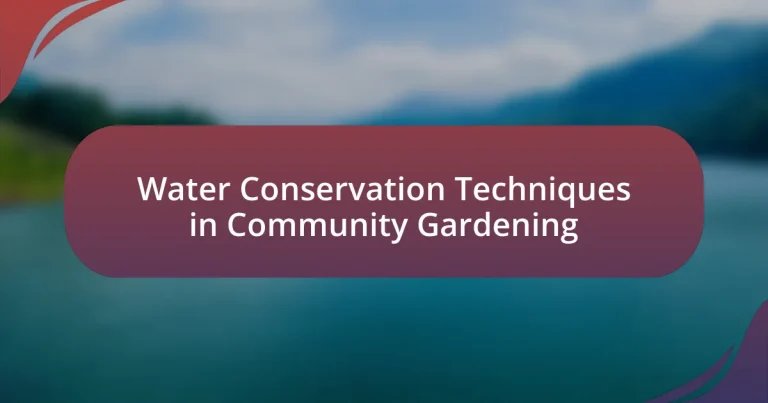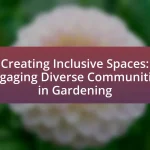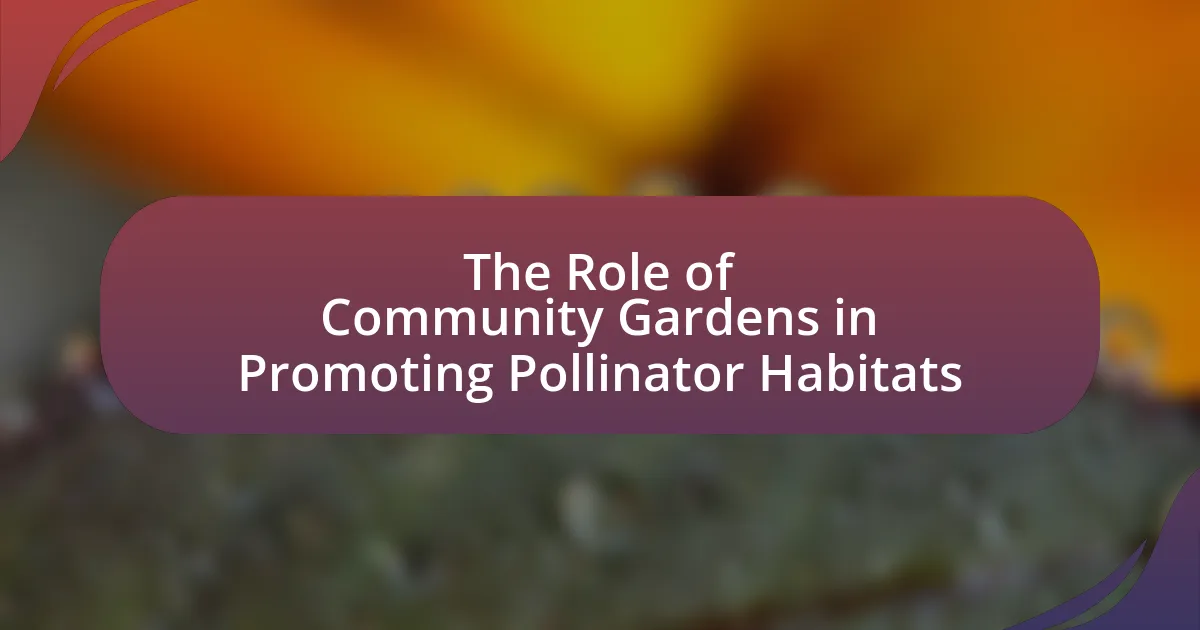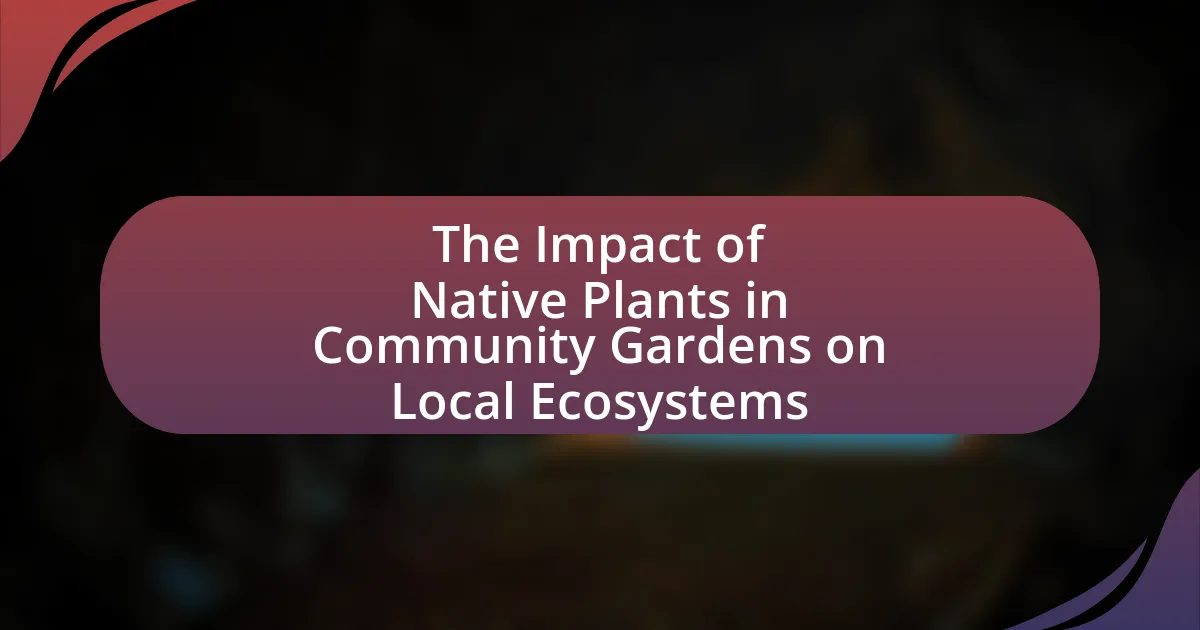Water conservation techniques in community gardening are essential for promoting sustainable practices and optimizing water use. Key methods include rainwater harvesting, drip irrigation, mulching, and xeriscaping, each contributing to reduced water waste and improved plant health. These techniques not only enhance soil moisture retention and minimize reliance on municipal water sources but also support biodiversity and ecosystem health. The article explores the principles behind these methods, their impact on plant growth, and practical tips for community gardeners to implement effective water conservation strategies. Additionally, it addresses the challenges faced by community gardens regarding water usage and highlights the benefits of community engagement in fostering sustainable gardening practices.
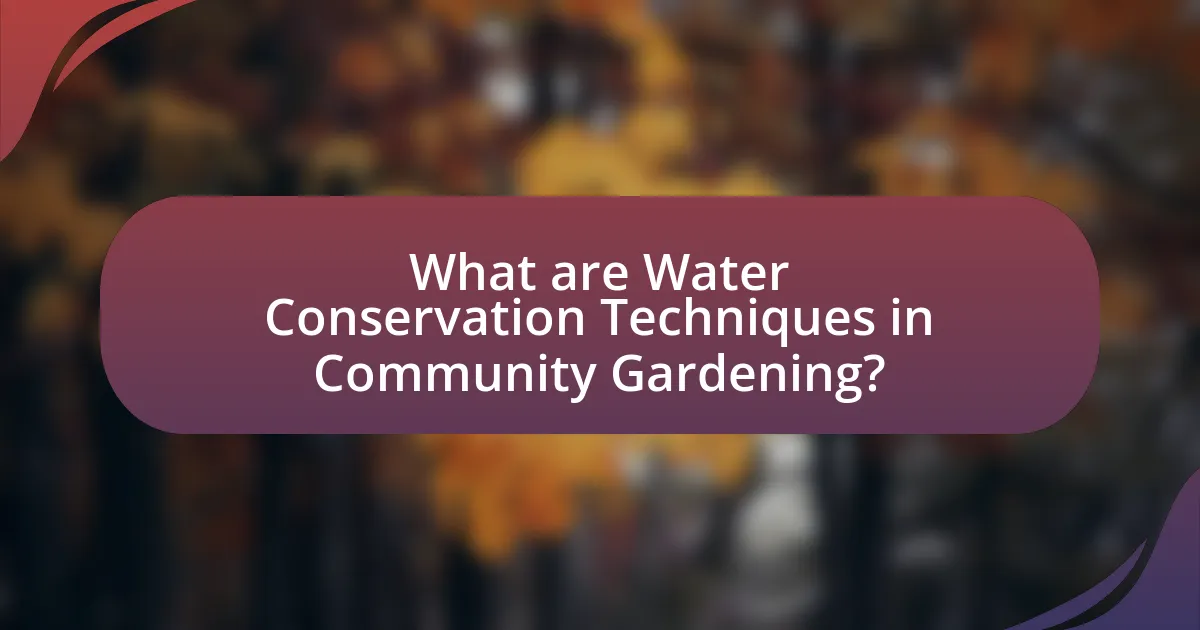
What are Water Conservation Techniques in Community Gardening?
Water conservation techniques in community gardening include methods such as rainwater harvesting, drip irrigation, mulching, and xeriscaping. Rainwater harvesting involves collecting and storing rainwater for irrigation, which can reduce reliance on municipal water sources. Drip irrigation delivers water directly to the plant roots, minimizing evaporation and runoff, and can use up to 60% less water than traditional methods. Mulching helps retain soil moisture and reduces the need for frequent watering by preventing evaporation. Xeriscaping incorporates drought-resistant plants that require less water, promoting sustainability in gardening practices. These techniques collectively enhance water efficiency and support sustainable community gardening initiatives.
How do these techniques contribute to sustainable gardening practices?
Water conservation techniques significantly enhance sustainable gardening practices by optimizing water use and reducing waste. These techniques, such as rainwater harvesting, drip irrigation, and mulching, ensure that water is used efficiently, minimizing the need for chemical fertilizers and pesticides that can harm the environment. For instance, drip irrigation delivers water directly to the plant roots, reducing evaporation and runoff, which can lead to a 30-50% reduction in water usage compared to traditional methods. Additionally, rainwater harvesting captures and utilizes natural precipitation, decreasing reliance on municipal water sources and promoting a self-sustaining ecosystem. These practices not only conserve water but also improve soil health and biodiversity, contributing to the overall resilience of community gardens.
What are the key principles behind water conservation in gardening?
The key principles behind water conservation in gardening include efficient irrigation practices, soil management, and plant selection. Efficient irrigation practices, such as drip irrigation and rainwater harvesting, minimize water waste by delivering water directly to the plant roots. Soil management techniques, like mulching and composting, enhance soil structure and moisture retention, reducing the need for frequent watering. Additionally, selecting drought-resistant plants ensures that gardens require less water, as these plants are adapted to thrive in low-water conditions. These principles collectively contribute to sustainable gardening practices that conserve water effectively.
How do water conservation techniques impact plant health and growth?
Water conservation techniques positively impact plant health and growth by optimizing water usage and enhancing soil moisture retention. Techniques such as drip irrigation and mulching reduce water waste and provide consistent moisture levels, which are crucial for plant development. Research indicates that plants receiving adequate moisture through these methods exhibit improved root development and increased resilience to drought conditions, leading to higher yields. For instance, a study published in the Journal of Soil and Water Conservation found that drip irrigation can increase crop yields by up to 30% compared to traditional irrigation methods, demonstrating the effectiveness of water conservation techniques in promoting plant health.
Why is water conservation important in community gardening?
Water conservation is crucial in community gardening because it ensures sustainable plant growth while minimizing resource waste. Efficient water use helps maintain soil health, supports biodiversity, and reduces the environmental impact of gardening practices. According to the U.S. Environmental Protection Agency, outdoor water use can account for nearly 30% of total household water consumption, highlighting the need for conservation strategies in community gardens to promote responsible water management and protect local water supplies.
What challenges do community gardens face regarding water usage?
Community gardens face significant challenges regarding water usage, primarily due to limited access to reliable water sources and the need for efficient irrigation methods. Many community gardens are located in urban areas where water supply can be inconsistent, leading to difficulties in maintaining healthy plants. Additionally, the lack of infrastructure for rainwater harvesting or irrigation systems can exacerbate water scarcity. Research indicates that approximately 40% of urban community gardens struggle with inadequate water supply, which directly impacts crop yields and sustainability. Furthermore, the rising costs of water in many regions pose financial challenges for community gardeners, making it essential to adopt water conservation techniques to mitigate these issues.
How does water conservation benefit the local ecosystem?
Water conservation benefits the local ecosystem by maintaining the balance of natural habitats and supporting biodiversity. When water is conserved, it reduces the depletion of local water sources, which helps sustain wetlands, rivers, and lakes that are crucial for various plant and animal species. For instance, studies show that conserving water can lead to healthier aquatic ecosystems, as it prevents the over-extraction of water that can lead to habitat destruction and loss of species. Additionally, efficient water use in community gardening minimizes runoff and pollution, further protecting local flora and fauna.
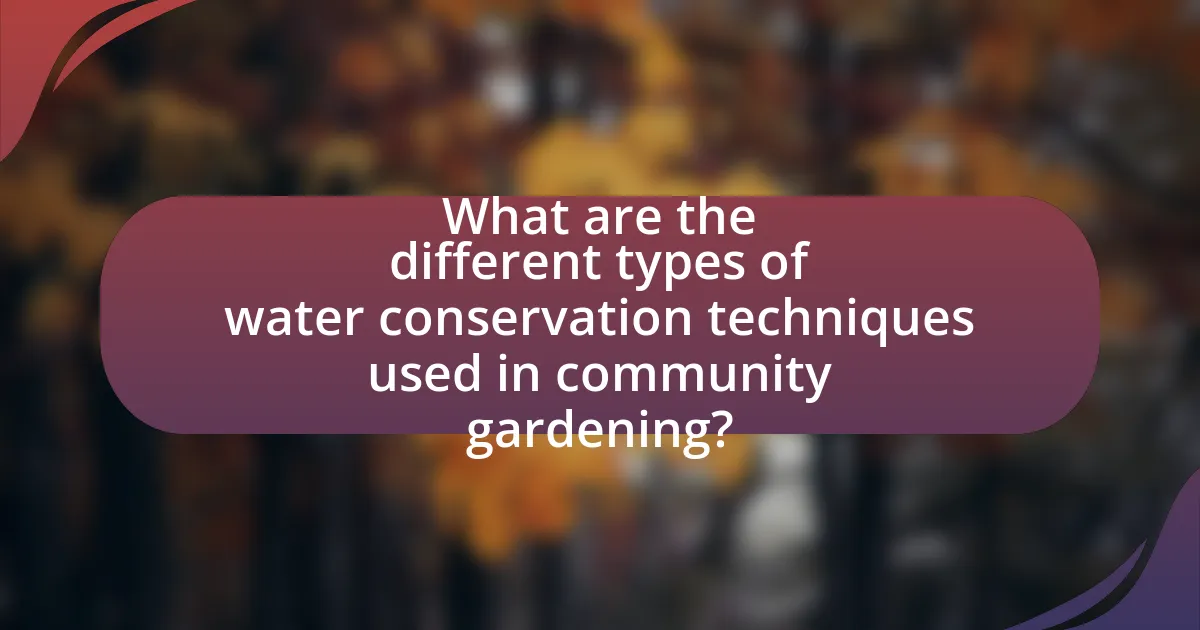
What are the different types of water conservation techniques used in community gardening?
Different types of water conservation techniques used in community gardening include rainwater harvesting, drip irrigation, mulching, and xeriscaping. Rainwater harvesting involves collecting and storing rainwater for irrigation, which can reduce reliance on municipal water sources. Drip irrigation delivers water directly to the plant roots, minimizing evaporation and runoff, thus increasing efficiency. Mulching helps retain soil moisture and reduces the need for frequent watering by preventing evaporation. Xeriscaping is a landscaping approach that uses drought-resistant plants, which require less water, making it suitable for areas with limited water supply. These techniques collectively enhance water efficiency and sustainability in community gardening.
How can rainwater harvesting be implemented in community gardens?
Rainwater harvesting can be implemented in community gardens by installing rain barrels or cisterns to collect and store rainwater from rooftops or other surfaces. This system allows gardeners to utilize collected rainwater for irrigation, reducing reliance on municipal water sources. According to the American Rainwater Catchment Systems Association, a properly designed rainwater harvesting system can capture thousands of gallons of water annually, significantly benefiting garden sustainability and water conservation efforts.
What are the steps to set up a rainwater collection system?
To set up a rainwater collection system, follow these steps: First, select an appropriate location for the collection system, ideally near downspouts or areas where rainwater naturally flows. Next, install a rain barrel or cistern to collect the water; ensure it has a secure lid to prevent contamination and mosquito breeding. Then, connect the barrel to the downspout using a diverter or direct the flow into the barrel. After that, incorporate a filtration system to remove debris and contaminants before the water is stored. Finally, ensure that the collected rainwater is used efficiently for irrigation or other non-potable purposes, adhering to local regulations regarding rainwater use. These steps are supported by guidelines from organizations like the American Rainwater Catchment Systems Association, which emphasizes the importance of proper installation and maintenance for effective water conservation.
What are the benefits of using rainwater for irrigation?
Using rainwater for irrigation provides several benefits, including cost savings, environmental sustainability, and improved plant health. Rainwater harvesting reduces reliance on municipal water supplies, leading to lower water bills and conservation of treated water resources. Additionally, rainwater is typically free of chemicals found in tap water, such as chlorine, which can be harmful to plants. Studies indicate that using rainwater can enhance soil moisture retention and promote healthier plant growth, as it is often at a neutral pH level, making it more suitable for irrigation. Furthermore, capturing rainwater helps mitigate stormwater runoff, reducing erosion and pollution in local waterways.
What role does mulching play in water conservation?
Mulching plays a crucial role in water conservation by reducing evaporation from the soil surface. This layer of organic or inorganic material helps maintain soil moisture, which is essential for plant health and growth. Studies indicate that mulched areas can retain up to 50% more moisture compared to bare soil, significantly decreasing the need for irrigation. Additionally, mulching prevents soil erosion and suppresses weed growth, further enhancing water retention and promoting efficient water use in community gardening.
How does mulching reduce water evaporation from the soil?
Mulching reduces water evaporation from the soil by creating a barrier that minimizes direct exposure of the soil surface to sunlight and wind. This barrier helps retain moisture in the soil by reducing the temperature fluctuations and preventing the wind from drying out the soil. Studies have shown that mulched areas can retain up to 50% more moisture compared to unmulched areas, significantly enhancing water conservation in gardening practices.
What materials are best for effective mulching in gardens?
Organic materials such as straw, wood chips, grass clippings, and shredded leaves are best for effective mulching in gardens. These materials not only suppress weeds but also retain soil moisture, improve soil structure, and provide nutrients as they decompose. For instance, straw can reduce evaporation by up to 50%, while wood chips can last for several years, providing long-term benefits. Additionally, research indicates that organic mulches can enhance microbial activity in the soil, further promoting plant health and water conservation.
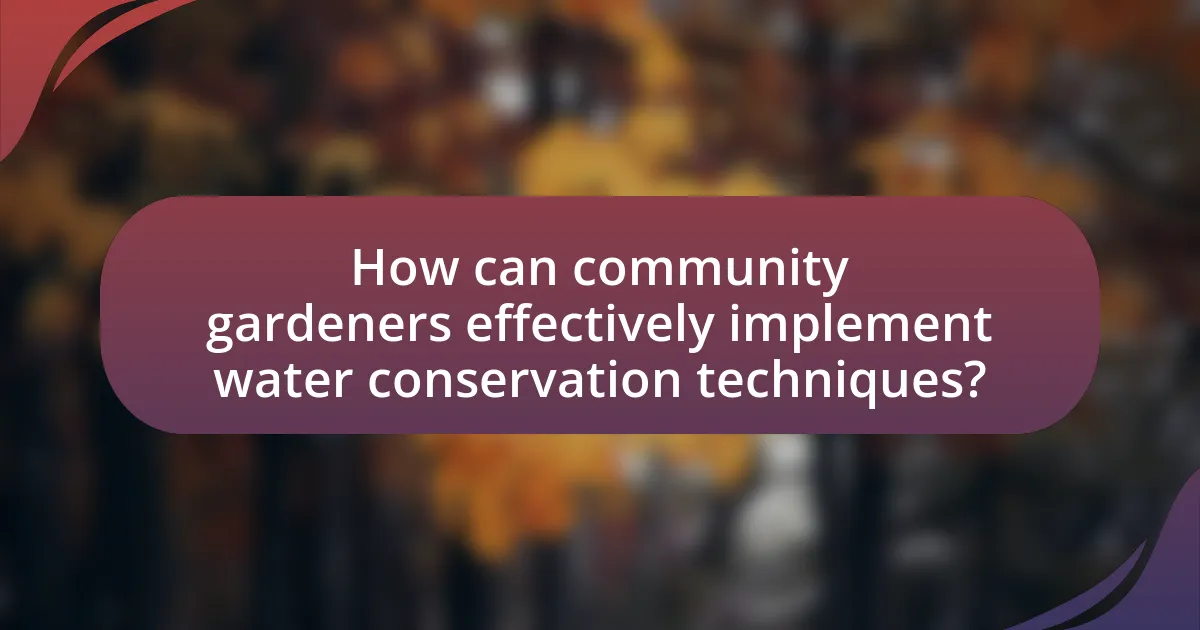
How can community gardeners effectively implement water conservation techniques?
Community gardeners can effectively implement water conservation techniques by utilizing methods such as drip irrigation, mulching, and rainwater harvesting. Drip irrigation delivers water directly to the plant roots, minimizing evaporation and runoff, which can save up to 50% more water compared to traditional watering methods. Mulching helps retain soil moisture and reduces the need for frequent watering by preventing evaporation. Rainwater harvesting systems can collect and store rainwater for irrigation, providing a sustainable water source and reducing reliance on municipal water supplies. These techniques not only conserve water but also promote healthier plant growth and reduce overall gardening costs.
What are the best practices for efficient irrigation systems?
The best practices for efficient irrigation systems include using drip irrigation, scheduling watering during cooler times of the day, and implementing soil moisture sensors. Drip irrigation delivers water directly to the plant roots, minimizing evaporation and runoff, which can save up to 30-50% more water compared to traditional methods. Watering during early morning or late evening reduces evaporation losses, as temperatures are lower. Soil moisture sensors provide real-time data on soil moisture levels, allowing for precise watering and preventing over-irrigation, which can lead to water waste and plant stress. These practices collectively enhance water conservation in community gardening.
How can drip irrigation systems be optimized for water savings?
Drip irrigation systems can be optimized for water savings by implementing precise scheduling, using pressure regulators, and incorporating soil moisture sensors. Precise scheduling ensures that water is delivered only when plants need it, reducing waste. Pressure regulators maintain consistent water pressure, preventing over-irrigation. Soil moisture sensors provide real-time data on soil conditions, allowing for adjustments in irrigation timing and volume. Research indicates that these methods can reduce water usage by up to 30% compared to traditional irrigation methods, demonstrating their effectiveness in conserving water in community gardening.
What are the advantages of using smart irrigation technology?
Smart irrigation technology offers significant advantages, including enhanced water efficiency, reduced labor costs, and improved crop health. This technology utilizes sensors and automated systems to deliver precise amounts of water based on real-time data, which can lead to water savings of up to 50% compared to traditional irrigation methods. Additionally, smart irrigation systems can minimize the need for manual monitoring and adjustments, thereby lowering labor costs. Research indicates that optimized watering schedules can also promote healthier plant growth, resulting in higher yields and better quality produce.
How can community engagement enhance water conservation efforts?
Community engagement enhances water conservation efforts by fostering collective responsibility and awareness among residents. When communities actively participate in water conservation initiatives, they are more likely to adopt sustainable practices, such as rainwater harvesting and xeriscaping. Research indicates that community-led programs can lead to a 20-30% reduction in water usage, as seen in various urban gardening projects where local involvement increased the implementation of efficient irrigation systems. Engaging community members also facilitates knowledge sharing, enabling individuals to learn from each other’s experiences and successes in conserving water.
What educational programs can promote water conservation in gardening?
Educational programs that can promote water conservation in gardening include workshops on xeriscaping, which teaches participants how to design landscapes that require minimal irrigation. Additionally, programs focused on rainwater harvesting educate gardeners on collecting and utilizing rainwater for irrigation, significantly reducing water usage. Community-based initiatives, such as the Master Gardener program, provide training on efficient watering techniques and the use of drought-resistant plants. Research indicates that these educational efforts can lead to a 30% reduction in water consumption in gardens, demonstrating their effectiveness in promoting sustainable gardening practices.
How can community members collaborate to share resources for water conservation?
Community members can collaborate to share resources for water conservation by establishing a resource-sharing network that includes rainwater harvesting systems, irrigation tools, and educational workshops. This collaboration can be facilitated through community meetings where members identify shared needs and resources, allowing them to pool their efforts and reduce individual costs. For instance, a study by the American Society of Civil Engineers highlights that community-based water conservation initiatives can lead to a 20-30% reduction in water usage when resources are shared effectively. By working together, community members can implement collective strategies that enhance water efficiency and promote sustainable gardening practices.
What practical tips can community gardeners follow for effective water conservation?
Community gardeners can implement several practical tips for effective water conservation, including using drip irrigation systems, mulching, and selecting drought-resistant plants. Drip irrigation delivers water directly to the plant roots, minimizing evaporation and runoff, which can save up to 50% more water compared to traditional watering methods. Mulching helps retain soil moisture and reduces the need for frequent watering by preventing evaporation. Additionally, choosing drought-resistant plants can significantly lower water usage, as these plants are adapted to thrive in low-water conditions, further promoting sustainability in community gardens.
